Analyzing Aboriginal Community Housing Problems: A Media-Based Report
VerifiedAdded on 2023/06/03
|16
|4113
|226
Report
AI Summary
This report examines the critical issue of poor housing in Aboriginal communities in Australia, focusing on its impact on health and well-being. Through the analysis of various media sources, the report highlights the chronic overcrowding, inadequate housing conditions, and the spread of diseases like scabies due to homelessness and lack of proper sanitation. It links these issues to broader debates around government funding, housing programs, and the need for culturally sensitive solutions. The report also reflects on the importance of addressing the social determinants of health and the limitations of healthcare interventions without addressing the underlying housing crisis. Furthermore, the report acknowledges the need for collaboration between government, healthcare sectors, and local communities to improve the living conditions and health outcomes for Aboriginal Australians.
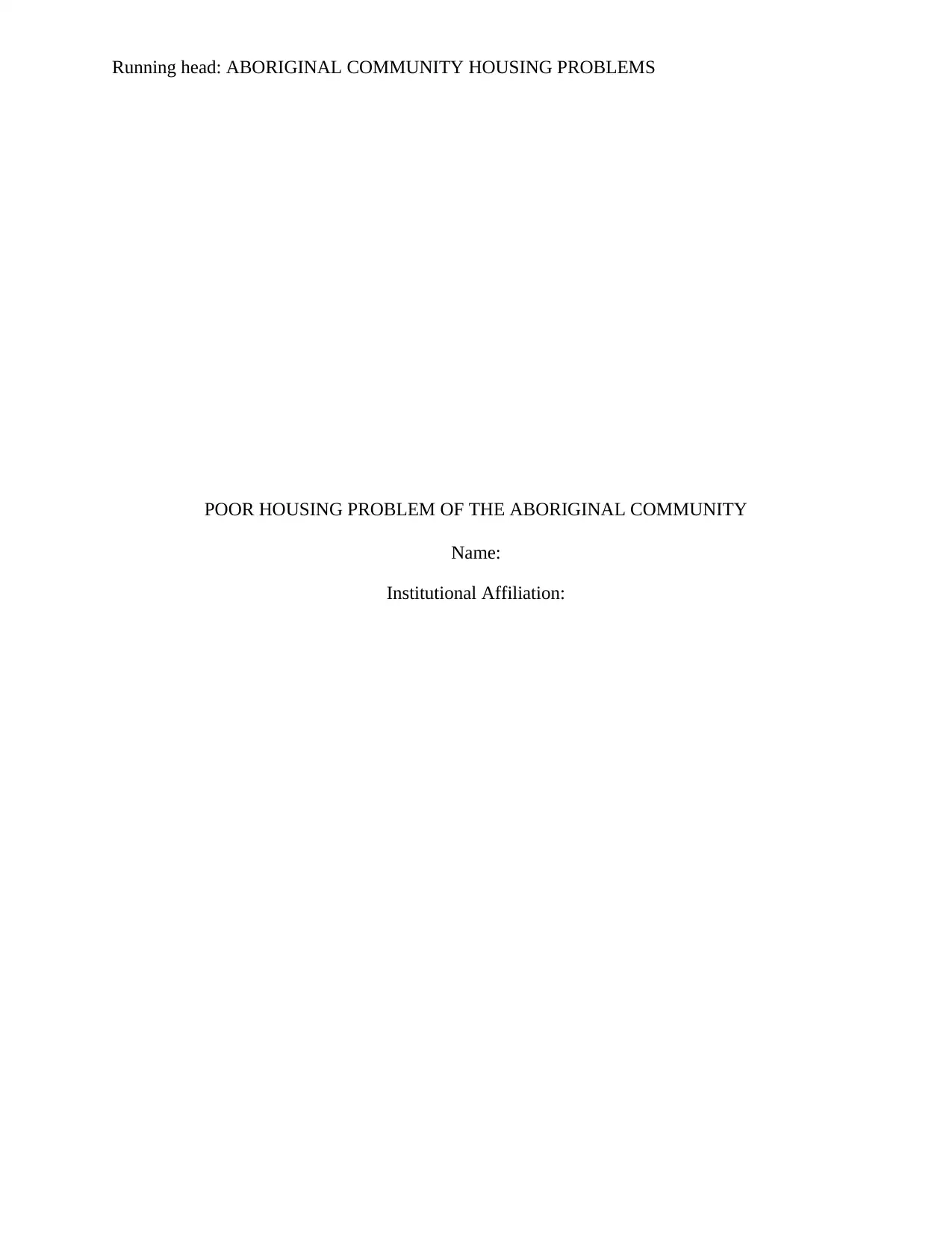
Running head: ABORIGINAL COMMUNITY HOUSING PROBLEMS
POOR HOUSING PROBLEM OF THE ABORIGINAL COMMUNITY
Name:
Institutional Affiliation:
POOR HOUSING PROBLEM OF THE ABORIGINAL COMMUNITY
Name:
Institutional Affiliation:
Paraphrase This Document
Need a fresh take? Get an instant paraphrase of this document with our AI Paraphraser

ABORIGINAL COMMUNITY HOUSING PROBLEM
2
Introduction
Shelter and housing are some of the most important living conditions which are
recognized to be fundamental for health. The benefits of having shelter are associated with
various health benefits. The poor housing is associated with less housing availability, the design
of the houses, surroundings, the condition of the housing and the constructions. Australia is very
vast with a number of citizens living out of the towns and cities. The disadvantaged groups such
as the indigenous communities right from colonization face challenges such as poor housing and
lack of better. Isolation of small-sized communities contributes to issues of housing acute in
remote and rural areas (Habibis, 2013).
One of the significant determinants of the poor health status of the Aboriginals
Australians is poor housing. Children are more vulnerable to infections in these living
conditions. Despite the majority of the aboriginal Australians residing in the urban areas, most of
the research on housing and its connection with health issues has been conducted in the remote
areas targeting the remote communities (McNamara, Cassells, Wicks & Vidyattama, 2010). Poor
housing, household overcrowding, and poor hygiene practices directly or indirectly dominate
some of the social and health problems present in the remote Aboriginal communities.
Considering the housing issue and health, this paper addresses this issue by analyzing different
media sources.
The paper aims at addressing some of the associated factors linked to health and poor
housing. A summary of each media item and linking the indigenous approaches and models on
the current debate topics is illustrated, and I will also include my reflection.
2
Introduction
Shelter and housing are some of the most important living conditions which are
recognized to be fundamental for health. The benefits of having shelter are associated with
various health benefits. The poor housing is associated with less housing availability, the design
of the houses, surroundings, the condition of the housing and the constructions. Australia is very
vast with a number of citizens living out of the towns and cities. The disadvantaged groups such
as the indigenous communities right from colonization face challenges such as poor housing and
lack of better. Isolation of small-sized communities contributes to issues of housing acute in
remote and rural areas (Habibis, 2013).
One of the significant determinants of the poor health status of the Aboriginals
Australians is poor housing. Children are more vulnerable to infections in these living
conditions. Despite the majority of the aboriginal Australians residing in the urban areas, most of
the research on housing and its connection with health issues has been conducted in the remote
areas targeting the remote communities (McNamara, Cassells, Wicks & Vidyattama, 2010). Poor
housing, household overcrowding, and poor hygiene practices directly or indirectly dominate
some of the social and health problems present in the remote Aboriginal communities.
Considering the housing issue and health, this paper addresses this issue by analyzing different
media sources.
The paper aims at addressing some of the associated factors linked to health and poor
housing. A summary of each media item and linking the indigenous approaches and models on
the current debate topics is illustrated, and I will also include my reflection.
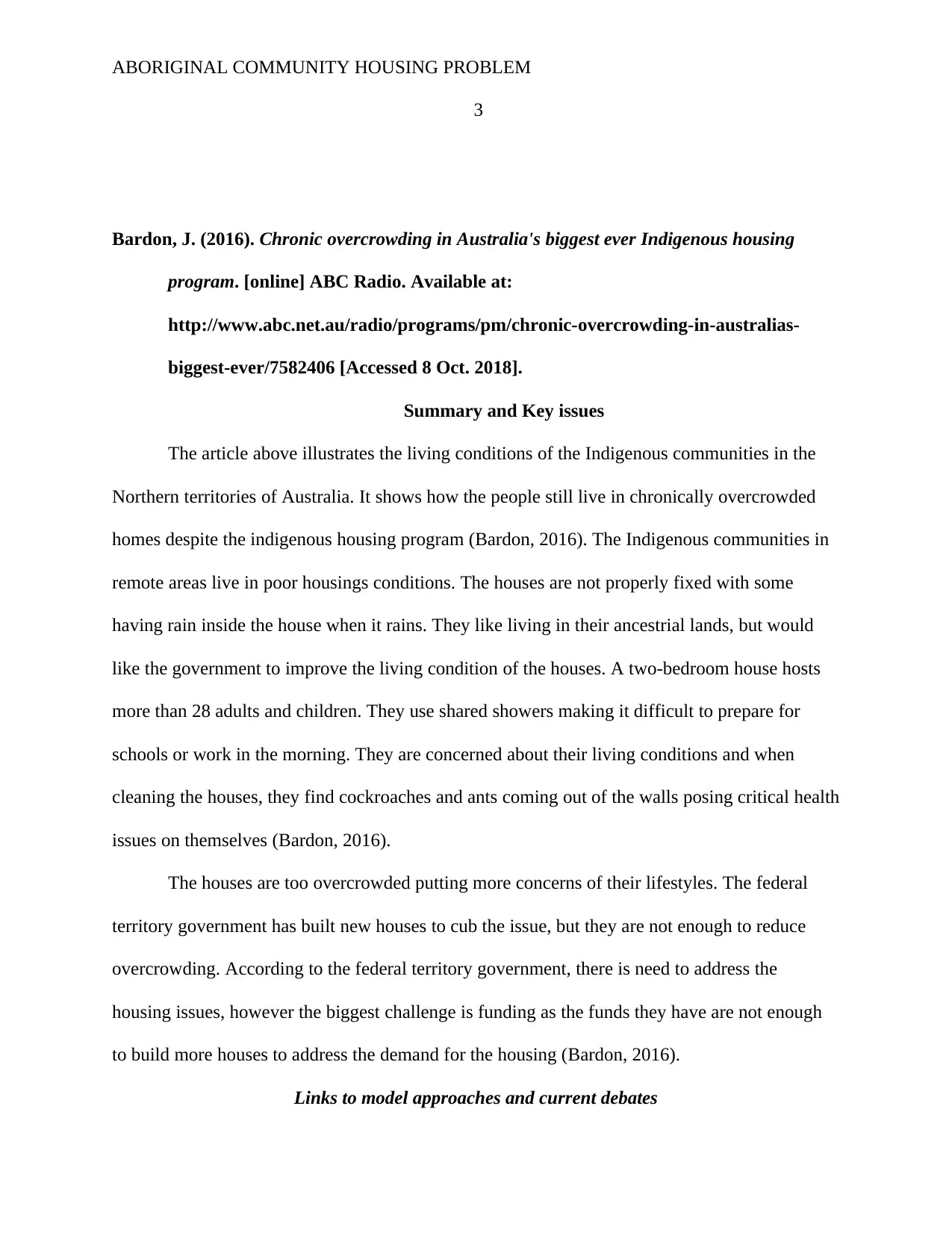
ABORIGINAL COMMUNITY HOUSING PROBLEM
3
Bardon, J. (2016). Chronic overcrowding in Australia's biggest ever Indigenous housing
program. [online] ABC Radio. Available at:
http://www.abc.net.au/radio/programs/pm/chronic-overcrowding-in-australias-
biggest-ever/7582406 [Accessed 8 Oct. 2018].
Summary and Key issues
The article above illustrates the living conditions of the Indigenous communities in the
Northern territories of Australia. It shows how the people still live in chronically overcrowded
homes despite the indigenous housing program (Bardon, 2016). The Indigenous communities in
remote areas live in poor housings conditions. The houses are not properly fixed with some
having rain inside the house when it rains. They like living in their ancestrial lands, but would
like the government to improve the living condition of the houses. A two-bedroom house hosts
more than 28 adults and children. They use shared showers making it difficult to prepare for
schools or work in the morning. They are concerned about their living conditions and when
cleaning the houses, they find cockroaches and ants coming out of the walls posing critical health
issues on themselves (Bardon, 2016).
The houses are too overcrowded putting more concerns of their lifestyles. The federal
territory government has built new houses to cub the issue, but they are not enough to reduce
overcrowding. According to the federal territory government, there is need to address the
housing issues, however the biggest challenge is funding as the funds they have are not enough
to build more houses to address the demand for the housing (Bardon, 2016).
Links to model approaches and current debates
3
Bardon, J. (2016). Chronic overcrowding in Australia's biggest ever Indigenous housing
program. [online] ABC Radio. Available at:
http://www.abc.net.au/radio/programs/pm/chronic-overcrowding-in-australias-
biggest-ever/7582406 [Accessed 8 Oct. 2018].
Summary and Key issues
The article above illustrates the living conditions of the Indigenous communities in the
Northern territories of Australia. It shows how the people still live in chronically overcrowded
homes despite the indigenous housing program (Bardon, 2016). The Indigenous communities in
remote areas live in poor housings conditions. The houses are not properly fixed with some
having rain inside the house when it rains. They like living in their ancestrial lands, but would
like the government to improve the living condition of the houses. A two-bedroom house hosts
more than 28 adults and children. They use shared showers making it difficult to prepare for
schools or work in the morning. They are concerned about their living conditions and when
cleaning the houses, they find cockroaches and ants coming out of the walls posing critical health
issues on themselves (Bardon, 2016).
The houses are too overcrowded putting more concerns of their lifestyles. The federal
territory government has built new houses to cub the issue, but they are not enough to reduce
overcrowding. According to the federal territory government, there is need to address the
housing issues, however the biggest challenge is funding as the funds they have are not enough
to build more houses to address the demand for the housing (Bardon, 2016).
Links to model approaches and current debates
⊘ This is a preview!⊘
Do you want full access?
Subscribe today to unlock all pages.

Trusted by 1+ million students worldwide

ABORIGINAL COMMUNITY HOUSING PROBLEM
4
The characteristics of the aboriginal families being larger and lack sufficient affordable
homes to accommodate them is widely noticed. Andersen, Williamson, Fernando, Redman and
Vincent, (2016) add that, in the urban areas the aboriginal families are expected to host the
extended families who visit in search of better services. Households suffer from sufficient space,
basic amenities, and privacy. The children have no space to sleep, play or do their homework.
The environment turns out to be stressful, problematic and determinant of health. The poor
housing conditions of the already overcrowded housings are characterised with poor insulations,
leading problems such as damp, leaking rooves, faulty plumbing, moulds, broken amenities and
poor temperature control. The poor housing conditions are associated with negative effects on
physical health, emotional and social well-being of the Aboriginal families.
According to Andersen et al., (2016), houses characterised by overcrowding affects the
health of the community members. The poor living conditions are key drivers to communicable
diseases such as gastroenteritis, skin infections or namely cold. Asthma and respiratory diseases
are associated with moulds and dampness. The injuries posed by faulty household fixtures are
also concerns. The emotional and social wellbeing are associated with stress leading to
depression and other mental disorders (Lyons & Janca, 2012) adds that the Aboriginal children
not only face challenges at homes, but also face a lot of bullying in schools and givent the living
conditions, they end up suffering from anxiety, depression and psychosis disorders. The children
and elderly living with chronic diseases are severely affected in these living conditions.
Overcrowding is problems which cause lots of strains on couple and family relationships,
affecting their emotional wellbeing.
Personal Reflection
4
The characteristics of the aboriginal families being larger and lack sufficient affordable
homes to accommodate them is widely noticed. Andersen, Williamson, Fernando, Redman and
Vincent, (2016) add that, in the urban areas the aboriginal families are expected to host the
extended families who visit in search of better services. Households suffer from sufficient space,
basic amenities, and privacy. The children have no space to sleep, play or do their homework.
The environment turns out to be stressful, problematic and determinant of health. The poor
housing conditions of the already overcrowded housings are characterised with poor insulations,
leading problems such as damp, leaking rooves, faulty plumbing, moulds, broken amenities and
poor temperature control. The poor housing conditions are associated with negative effects on
physical health, emotional and social well-being of the Aboriginal families.
According to Andersen et al., (2016), houses characterised by overcrowding affects the
health of the community members. The poor living conditions are key drivers to communicable
diseases such as gastroenteritis, skin infections or namely cold. Asthma and respiratory diseases
are associated with moulds and dampness. The injuries posed by faulty household fixtures are
also concerns. The emotional and social wellbeing are associated with stress leading to
depression and other mental disorders (Lyons & Janca, 2012) adds that the Aboriginal children
not only face challenges at homes, but also face a lot of bullying in schools and givent the living
conditions, they end up suffering from anxiety, depression and psychosis disorders. The children
and elderly living with chronic diseases are severely affected in these living conditions.
Overcrowding is problems which cause lots of strains on couple and family relationships,
affecting their emotional wellbeing.
Personal Reflection
Paraphrase This Document
Need a fresh take? Get an instant paraphrase of this document with our AI Paraphraser

ABORIGINAL COMMUNITY HOUSING PROBLEM
5
The author of the article is successful in bringing primary data on some of the challenges
faced by the Aboriginal communities leaving in overcrowded homes. The health issues resulting
from the overcrowdings of the houses are very serious and need to be addressed. The housing
problems affect the physical, social and emotional wellbeing of people posing serious health
issues to the affected.
Quilty, S. (2017). Why the housing shortage exacerbates scabies in Indigenous communities.
[online] NITV. Available at:
https://www.sbs.com.au/nitv/nitv-news/article/2017/02/07/why-housing-shortage-
exacerbates-scabies-indigenous-communities [Accessed 8 Oct. 2018].
Summary and key issues
The article describes how housing shortage intensifies the spread of scabies in the
indigenous communities. Scabies is described as a disease of the old past that is no longer known
to most of the Australian society. Though in the far remote Northern Territory, scabies infection
is considered to be very endemic and about 70% of the aboriginal children in the remote areas
have been infected by the disease in the first year of life (Quilty, 2017). Children are more
vulnerable to skin disease (Hendrickx, Bowen, Marsh, Carapetis & Walker, 2018) A recent
research done showed that one in 100 aboriginal people in the remote region of Katherine suffers
from scabies. The disease is linked to homelessness and remote leaving. One person with the
disease has a high chance of infecting others leading to extreme rates of infection among the
Aboriginal communities. The infection is highly contagious to people in contact with the affected
person leading to high level of spread of the disease (Aung, Cuningham, Hwang, Andrews,
Carapetis, Kearns, & Campbell, 2018).
5
The author of the article is successful in bringing primary data on some of the challenges
faced by the Aboriginal communities leaving in overcrowded homes. The health issues resulting
from the overcrowdings of the houses are very serious and need to be addressed. The housing
problems affect the physical, social and emotional wellbeing of people posing serious health
issues to the affected.
Quilty, S. (2017). Why the housing shortage exacerbates scabies in Indigenous communities.
[online] NITV. Available at:
https://www.sbs.com.au/nitv/nitv-news/article/2017/02/07/why-housing-shortage-
exacerbates-scabies-indigenous-communities [Accessed 8 Oct. 2018].
Summary and key issues
The article describes how housing shortage intensifies the spread of scabies in the
indigenous communities. Scabies is described as a disease of the old past that is no longer known
to most of the Australian society. Though in the far remote Northern Territory, scabies infection
is considered to be very endemic and about 70% of the aboriginal children in the remote areas
have been infected by the disease in the first year of life (Quilty, 2017). Children are more
vulnerable to skin disease (Hendrickx, Bowen, Marsh, Carapetis & Walker, 2018) A recent
research done showed that one in 100 aboriginal people in the remote region of Katherine suffers
from scabies. The disease is linked to homelessness and remote leaving. One person with the
disease has a high chance of infecting others leading to extreme rates of infection among the
Aboriginal communities. The infection is highly contagious to people in contact with the affected
person leading to high level of spread of the disease (Aung, Cuningham, Hwang, Andrews,
Carapetis, Kearns, & Campbell, 2018).
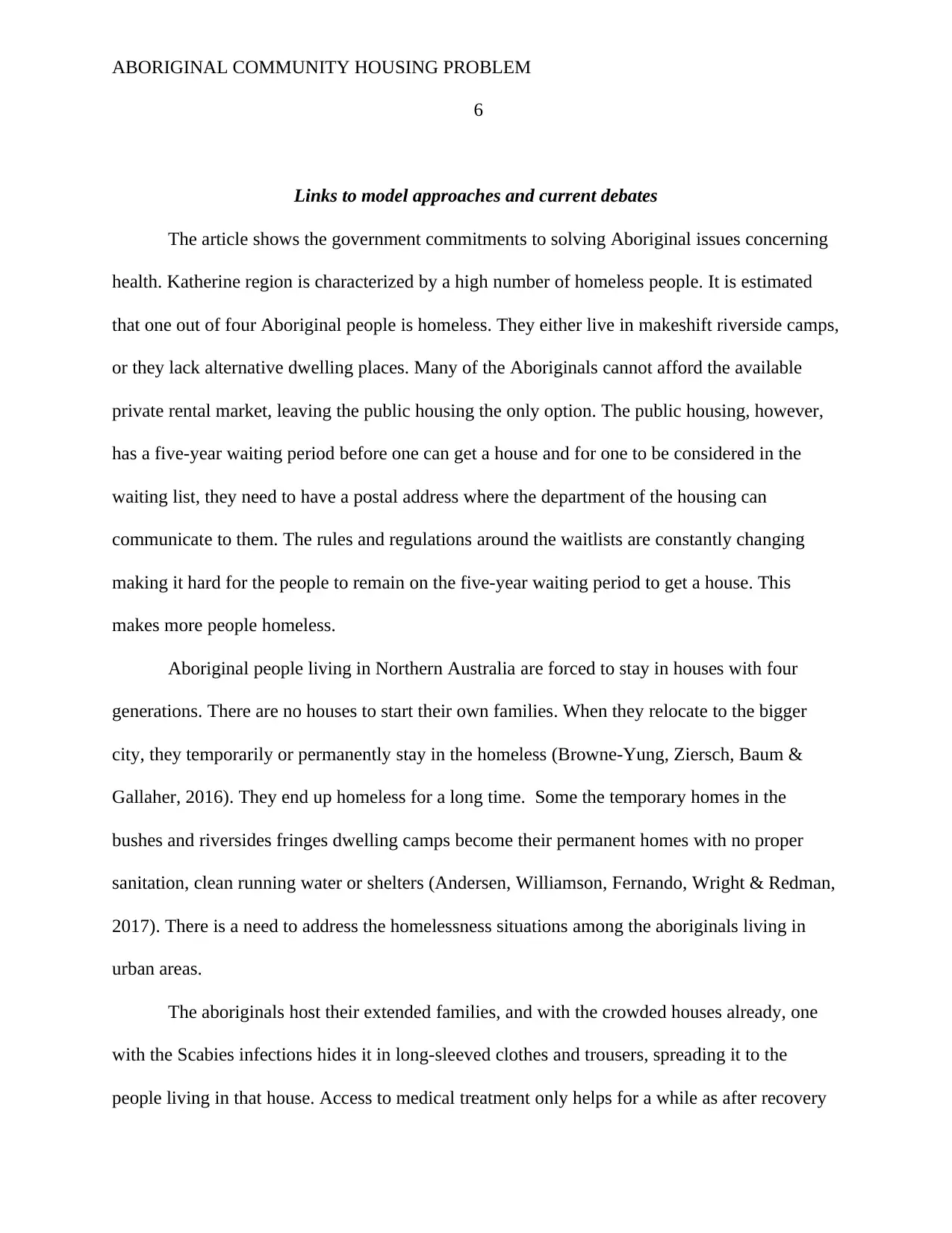
ABORIGINAL COMMUNITY HOUSING PROBLEM
6
Links to model approaches and current debates
The article shows the government commitments to solving Aboriginal issues concerning
health. Katherine region is characterized by a high number of homeless people. It is estimated
that one out of four Aboriginal people is homeless. They either live in makeshift riverside camps,
or they lack alternative dwelling places. Many of the Aboriginals cannot afford the available
private rental market, leaving the public housing the only option. The public housing, however,
has a five-year waiting period before one can get a house and for one to be considered in the
waiting list, they need to have a postal address where the department of the housing can
communicate to them. The rules and regulations around the waitlists are constantly changing
making it hard for the people to remain on the five-year waiting period to get a house. This
makes more people homeless.
Aboriginal people living in Northern Australia are forced to stay in houses with four
generations. There are no houses to start their own families. When they relocate to the bigger
city, they temporarily or permanently stay in the homeless (Browne-Yung, Ziersch, Baum &
Gallaher, 2016). They end up homeless for a long time. Some the temporary homes in the
bushes and riversides fringes dwelling camps become their permanent homes with no proper
sanitation, clean running water or shelters (Andersen, Williamson, Fernando, Wright & Redman,
2017). There is a need to address the homelessness situations among the aboriginals living in
urban areas.
The aboriginals host their extended families, and with the crowded houses already, one
with the Scabies infections hides it in long-sleeved clothes and trousers, spreading it to the
people living in that house. Access to medical treatment only helps for a while as after recovery
6
Links to model approaches and current debates
The article shows the government commitments to solving Aboriginal issues concerning
health. Katherine region is characterized by a high number of homeless people. It is estimated
that one out of four Aboriginal people is homeless. They either live in makeshift riverside camps,
or they lack alternative dwelling places. Many of the Aboriginals cannot afford the available
private rental market, leaving the public housing the only option. The public housing, however,
has a five-year waiting period before one can get a house and for one to be considered in the
waiting list, they need to have a postal address where the department of the housing can
communicate to them. The rules and regulations around the waitlists are constantly changing
making it hard for the people to remain on the five-year waiting period to get a house. This
makes more people homeless.
Aboriginal people living in Northern Australia are forced to stay in houses with four
generations. There are no houses to start their own families. When they relocate to the bigger
city, they temporarily or permanently stay in the homeless (Browne-Yung, Ziersch, Baum &
Gallaher, 2016). They end up homeless for a long time. Some the temporary homes in the
bushes and riversides fringes dwelling camps become their permanent homes with no proper
sanitation, clean running water or shelters (Andersen, Williamson, Fernando, Wright & Redman,
2017). There is a need to address the homelessness situations among the aboriginals living in
urban areas.
The aboriginals host their extended families, and with the crowded houses already, one
with the Scabies infections hides it in long-sleeved clothes and trousers, spreading it to the
people living in that house. Access to medical treatment only helps for a while as after recovery
⊘ This is a preview!⊘
Do you want full access?
Subscribe today to unlock all pages.

Trusted by 1+ million students worldwide
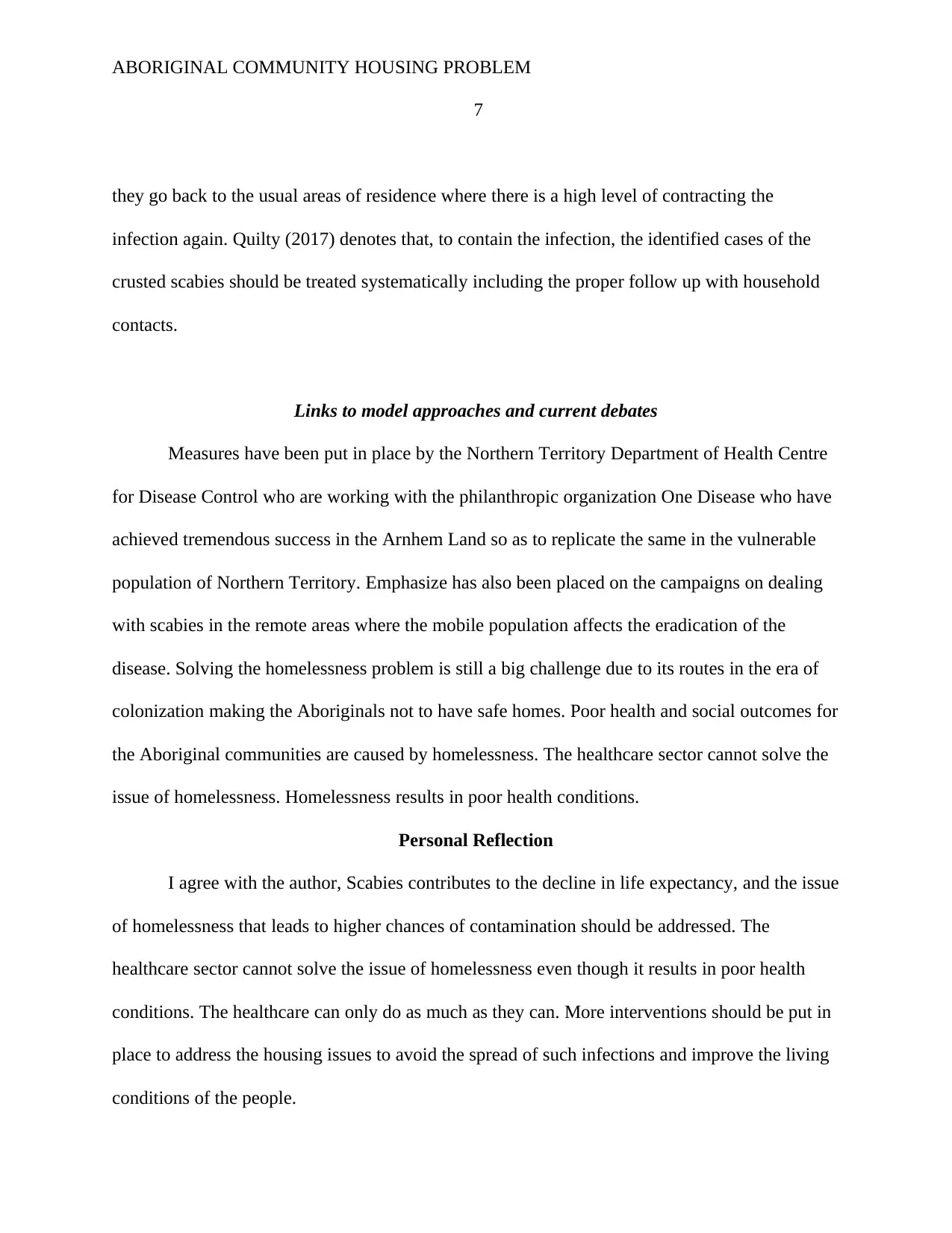
ABORIGINAL COMMUNITY HOUSING PROBLEM
7
they go back to the usual areas of residence where there is a high level of contracting the
infection again. Quilty (2017) denotes that, to contain the infection, the identified cases of the
crusted scabies should be treated systematically including the proper follow up with household
contacts.
Links to model approaches and current debates
Measures have been put in place by the Northern Territory Department of Health Centre
for Disease Control who are working with the philanthropic organization One Disease who have
achieved tremendous success in the Arnhem Land so as to replicate the same in the vulnerable
population of Northern Territory. Emphasize has also been placed on the campaigns on dealing
with scabies in the remote areas where the mobile population affects the eradication of the
disease. Solving the homelessness problem is still a big challenge due to its routes in the era of
colonization making the Aboriginals not to have safe homes. Poor health and social outcomes for
the Aboriginal communities are caused by homelessness. The healthcare sector cannot solve the
issue of homelessness. Homelessness results in poor health conditions.
Personal Reflection
I agree with the author, Scabies contributes to the decline in life expectancy, and the issue
of homelessness that leads to higher chances of contamination should be addressed. The
healthcare sector cannot solve the issue of homelessness even though it results in poor health
conditions. The healthcare can only do as much as they can. More interventions should be put in
place to address the housing issues to avoid the spread of such infections and improve the living
conditions of the people.
7
they go back to the usual areas of residence where there is a high level of contracting the
infection again. Quilty (2017) denotes that, to contain the infection, the identified cases of the
crusted scabies should be treated systematically including the proper follow up with household
contacts.
Links to model approaches and current debates
Measures have been put in place by the Northern Territory Department of Health Centre
for Disease Control who are working with the philanthropic organization One Disease who have
achieved tremendous success in the Arnhem Land so as to replicate the same in the vulnerable
population of Northern Territory. Emphasize has also been placed on the campaigns on dealing
with scabies in the remote areas where the mobile population affects the eradication of the
disease. Solving the homelessness problem is still a big challenge due to its routes in the era of
colonization making the Aboriginals not to have safe homes. Poor health and social outcomes for
the Aboriginal communities are caused by homelessness. The healthcare sector cannot solve the
issue of homelessness. Homelessness results in poor health conditions.
Personal Reflection
I agree with the author, Scabies contributes to the decline in life expectancy, and the issue
of homelessness that leads to higher chances of contamination should be addressed. The
healthcare sector cannot solve the issue of homelessness even though it results in poor health
conditions. The healthcare can only do as much as they can. More interventions should be put in
place to address the housing issues to avoid the spread of such infections and improve the living
conditions of the people.
Paraphrase This Document
Need a fresh take? Get an instant paraphrase of this document with our AI Paraphraser
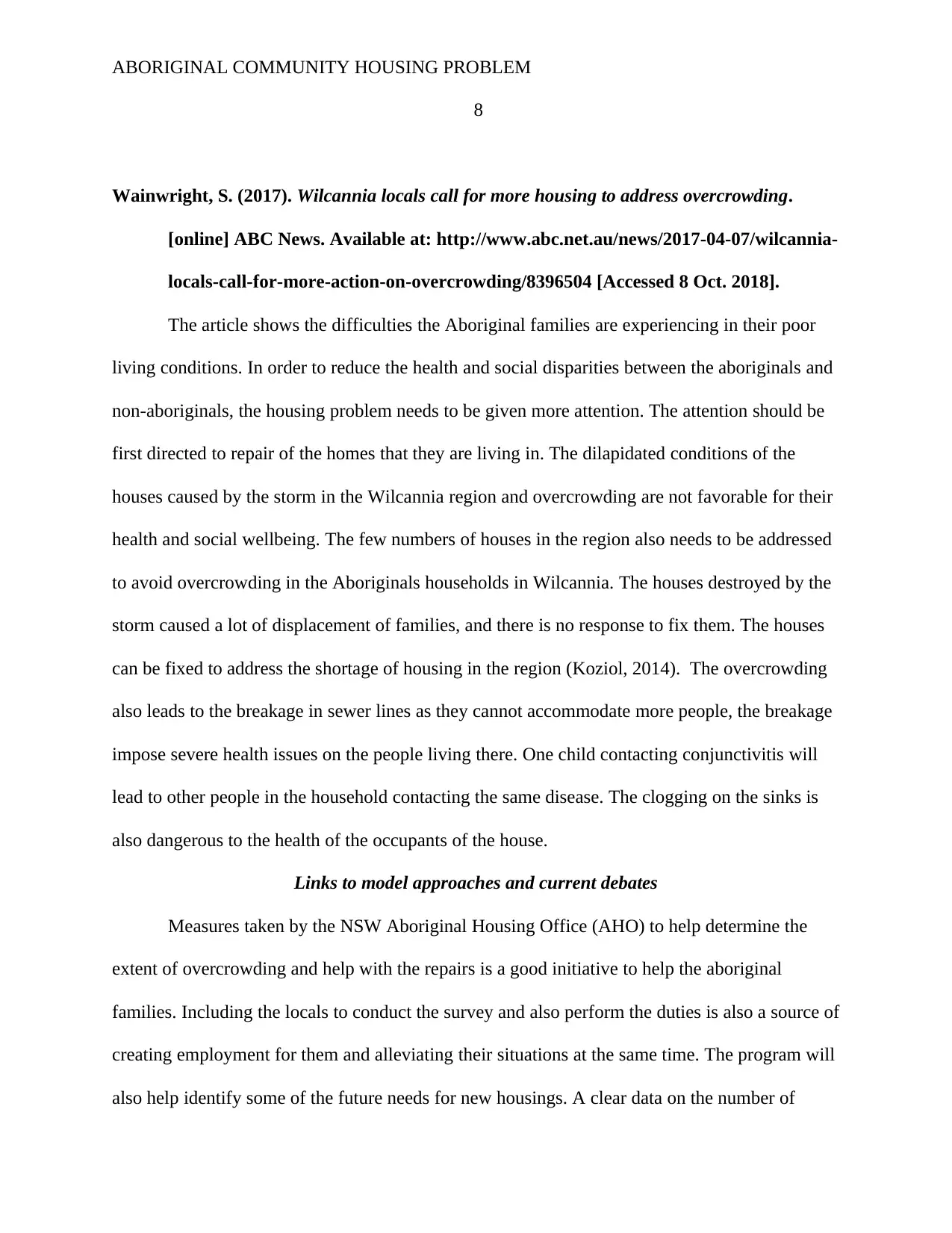
ABORIGINAL COMMUNITY HOUSING PROBLEM
8
Wainwright, S. (2017). Wilcannia locals call for more housing to address overcrowding.
[online] ABC News. Available at: http://www.abc.net.au/news/2017-04-07/wilcannia-
locals-call-for-more-action-on-overcrowding/8396504 [Accessed 8 Oct. 2018].
The article shows the difficulties the Aboriginal families are experiencing in their poor
living conditions. In order to reduce the health and social disparities between the aboriginals and
non-aboriginals, the housing problem needs to be given more attention. The attention should be
first directed to repair of the homes that they are living in. The dilapidated conditions of the
houses caused by the storm in the Wilcannia region and overcrowding are not favorable for their
health and social wellbeing. The few numbers of houses in the region also needs to be addressed
to avoid overcrowding in the Aboriginals households in Wilcannia. The houses destroyed by the
storm caused a lot of displacement of families, and there is no response to fix them. The houses
can be fixed to address the shortage of housing in the region (Koziol, 2014). The overcrowding
also leads to the breakage in sewer lines as they cannot accommodate more people, the breakage
impose severe health issues on the people living there. One child contacting conjunctivitis will
lead to other people in the household contacting the same disease. The clogging on the sinks is
also dangerous to the health of the occupants of the house.
Links to model approaches and current debates
Measures taken by the NSW Aboriginal Housing Office (AHO) to help determine the
extent of overcrowding and help with the repairs is a good initiative to help the aboriginal
families. Including the locals to conduct the survey and also perform the duties is also a source of
creating employment for them and alleviating their situations at the same time. The program will
also help identify some of the future needs for new housings. A clear data on the number of
8
Wainwright, S. (2017). Wilcannia locals call for more housing to address overcrowding.
[online] ABC News. Available at: http://www.abc.net.au/news/2017-04-07/wilcannia-
locals-call-for-more-action-on-overcrowding/8396504 [Accessed 8 Oct. 2018].
The article shows the difficulties the Aboriginal families are experiencing in their poor
living conditions. In order to reduce the health and social disparities between the aboriginals and
non-aboriginals, the housing problem needs to be given more attention. The attention should be
first directed to repair of the homes that they are living in. The dilapidated conditions of the
houses caused by the storm in the Wilcannia region and overcrowding are not favorable for their
health and social wellbeing. The few numbers of houses in the region also needs to be addressed
to avoid overcrowding in the Aboriginals households in Wilcannia. The houses destroyed by the
storm caused a lot of displacement of families, and there is no response to fix them. The houses
can be fixed to address the shortage of housing in the region (Koziol, 2014). The overcrowding
also leads to the breakage in sewer lines as they cannot accommodate more people, the breakage
impose severe health issues on the people living there. One child contacting conjunctivitis will
lead to other people in the household contacting the same disease. The clogging on the sinks is
also dangerous to the health of the occupants of the house.
Links to model approaches and current debates
Measures taken by the NSW Aboriginal Housing Office (AHO) to help determine the
extent of overcrowding and help with the repairs is a good initiative to help the aboriginal
families. Including the locals to conduct the survey and also perform the duties is also a source of
creating employment for them and alleviating their situations at the same time. The program will
also help identify some of the future needs for new housings. A clear data on the number of
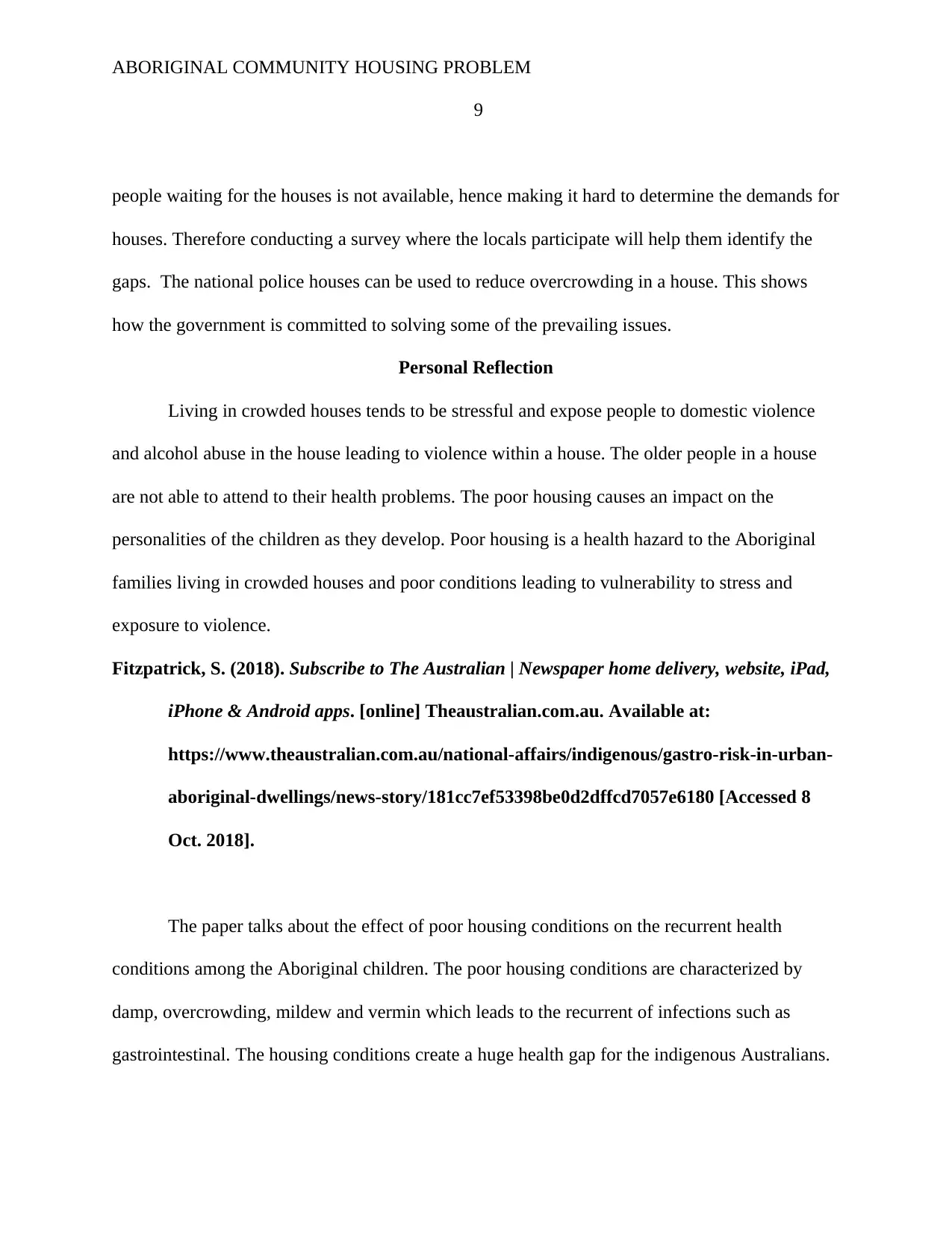
ABORIGINAL COMMUNITY HOUSING PROBLEM
9
people waiting for the houses is not available, hence making it hard to determine the demands for
houses. Therefore conducting a survey where the locals participate will help them identify the
gaps. The national police houses can be used to reduce overcrowding in a house. This shows
how the government is committed to solving some of the prevailing issues.
Personal Reflection
Living in crowded houses tends to be stressful and expose people to domestic violence
and alcohol abuse in the house leading to violence within a house. The older people in a house
are not able to attend to their health problems. The poor housing causes an impact on the
personalities of the children as they develop. Poor housing is a health hazard to the Aboriginal
families living in crowded houses and poor conditions leading to vulnerability to stress and
exposure to violence.
Fitzpatrick, S. (2018). Subscribe to The Australian | Newspaper home delivery, website, iPad,
iPhone & Android apps. [online] Theaustralian.com.au. Available at:
https://www.theaustralian.com.au/national-affairs/indigenous/gastro-risk-in-urban-
aboriginal-dwellings/news-story/181cc7ef53398be0d2dffcd7057e6180 [Accessed 8
Oct. 2018].
The paper talks about the effect of poor housing conditions on the recurrent health
conditions among the Aboriginal children. The poor housing conditions are characterized by
damp, overcrowding, mildew and vermin which leads to the recurrent of infections such as
gastrointestinal. The housing conditions create a huge health gap for the indigenous Australians.
9
people waiting for the houses is not available, hence making it hard to determine the demands for
houses. Therefore conducting a survey where the locals participate will help them identify the
gaps. The national police houses can be used to reduce overcrowding in a house. This shows
how the government is committed to solving some of the prevailing issues.
Personal Reflection
Living in crowded houses tends to be stressful and expose people to domestic violence
and alcohol abuse in the house leading to violence within a house. The older people in a house
are not able to attend to their health problems. The poor housing causes an impact on the
personalities of the children as they develop. Poor housing is a health hazard to the Aboriginal
families living in crowded houses and poor conditions leading to vulnerability to stress and
exposure to violence.
Fitzpatrick, S. (2018). Subscribe to The Australian | Newspaper home delivery, website, iPad,
iPhone & Android apps. [online] Theaustralian.com.au. Available at:
https://www.theaustralian.com.au/national-affairs/indigenous/gastro-risk-in-urban-
aboriginal-dwellings/news-story/181cc7ef53398be0d2dffcd7057e6180 [Accessed 8
Oct. 2018].
The paper talks about the effect of poor housing conditions on the recurrent health
conditions among the Aboriginal children. The poor housing conditions are characterized by
damp, overcrowding, mildew and vermin which leads to the recurrent of infections such as
gastrointestinal. The housing conditions create a huge health gap for the indigenous Australians.
⊘ This is a preview!⊘
Do you want full access?
Subscribe today to unlock all pages.

Trusted by 1+ million students worldwide

ABORIGINAL COMMUNITY HOUSING PROBLEM
10
Though Baker, Lester, and Bentley, (2016) note that, the issue of poor housing is prevalent
among Australians.
The aboriginals are not able to keep their homes warm enough during winter leading to
dampness or mildew (Bailie, Stevens, McDonald, Brewster & Guthridge, 2010). Overcrowding
is one of the main issues that saw many aboriginal children seek healthcare services. The housing
conditions in the urban areas for the Aboriginals need to be improved (Paswon, 2014) The author
also notes that it is not clear whether the improved housing conditions will result in improved
health outcomes for the Aboriginals in the urban areas.
Links to model approaches and current debates
Different housing problems present an increase in the risk of exposure to pathogens and
impairing peoples’ ability to seek and undertake healthy living practices. It is also difficult to
perform other wellbeing activities that may prevent vulnerability to infectious diseases. The
underlying issues affecting the Aboriginal communities need to be addressed. The concerns are
about the living conditions characterized by poor housing states, overcrowding and no repairs of
damaged houses (Ware, 2013). The healthcare sector can treat the affected children, but the
infections may reoccur as they go back to the same living conditions that make them susceptible
to infections. Apart from the infectious disease, unintentional injuries among children can be
prevented to close the health gap between the Aboriginal and non-Aboriginal children (Möller,
Falster, Ivers, Randall, Clapham, & Jorm, 2016).
Personal reflection
10
Though Baker, Lester, and Bentley, (2016) note that, the issue of poor housing is prevalent
among Australians.
The aboriginals are not able to keep their homes warm enough during winter leading to
dampness or mildew (Bailie, Stevens, McDonald, Brewster & Guthridge, 2010). Overcrowding
is one of the main issues that saw many aboriginal children seek healthcare services. The housing
conditions in the urban areas for the Aboriginals need to be improved (Paswon, 2014) The author
also notes that it is not clear whether the improved housing conditions will result in improved
health outcomes for the Aboriginals in the urban areas.
Links to model approaches and current debates
Different housing problems present an increase in the risk of exposure to pathogens and
impairing peoples’ ability to seek and undertake healthy living practices. It is also difficult to
perform other wellbeing activities that may prevent vulnerability to infectious diseases. The
underlying issues affecting the Aboriginal communities need to be addressed. The concerns are
about the living conditions characterized by poor housing states, overcrowding and no repairs of
damaged houses (Ware, 2013). The healthcare sector can treat the affected children, but the
infections may reoccur as they go back to the same living conditions that make them susceptible
to infections. Apart from the infectious disease, unintentional injuries among children can be
prevented to close the health gap between the Aboriginal and non-Aboriginal children (Möller,
Falster, Ivers, Randall, Clapham, & Jorm, 2016).
Personal reflection
Paraphrase This Document
Need a fresh take? Get an instant paraphrase of this document with our AI Paraphraser
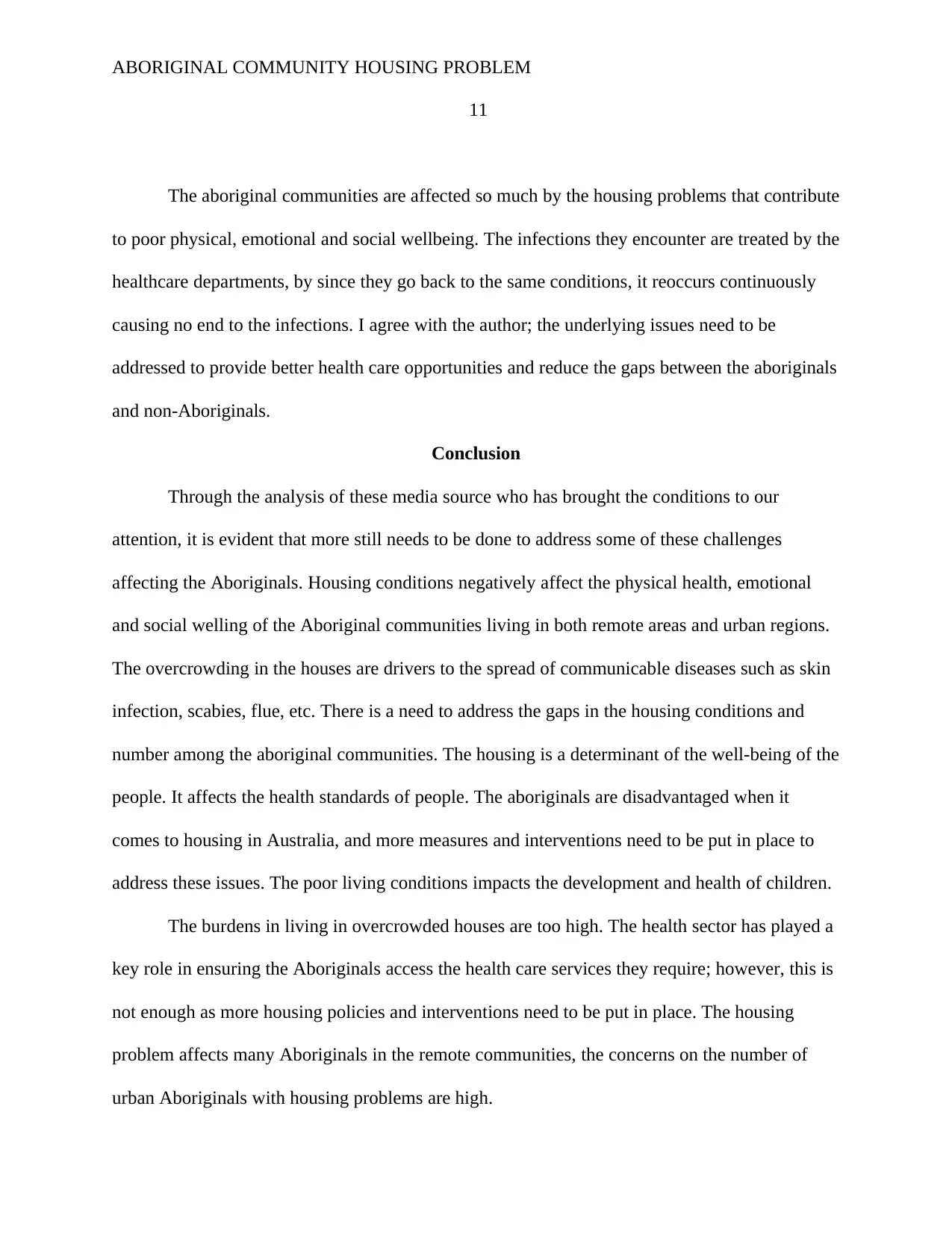
ABORIGINAL COMMUNITY HOUSING PROBLEM
11
The aboriginal communities are affected so much by the housing problems that contribute
to poor physical, emotional and social wellbeing. The infections they encounter are treated by the
healthcare departments, by since they go back to the same conditions, it reoccurs continuously
causing no end to the infections. I agree with the author; the underlying issues need to be
addressed to provide better health care opportunities and reduce the gaps between the aboriginals
and non-Aboriginals.
Conclusion
Through the analysis of these media source who has brought the conditions to our
attention, it is evident that more still needs to be done to address some of these challenges
affecting the Aboriginals. Housing conditions negatively affect the physical health, emotional
and social welling of the Aboriginal communities living in both remote areas and urban regions.
The overcrowding in the houses are drivers to the spread of communicable diseases such as skin
infection, scabies, flue, etc. There is a need to address the gaps in the housing conditions and
number among the aboriginal communities. The housing is a determinant of the well-being of the
people. It affects the health standards of people. The aboriginals are disadvantaged when it
comes to housing in Australia, and more measures and interventions need to be put in place to
address these issues. The poor living conditions impacts the development and health of children.
The burdens in living in overcrowded houses are too high. The health sector has played a
key role in ensuring the Aboriginals access the health care services they require; however, this is
not enough as more housing policies and interventions need to be put in place. The housing
problem affects many Aboriginals in the remote communities, the concerns on the number of
urban Aboriginals with housing problems are high.
11
The aboriginal communities are affected so much by the housing problems that contribute
to poor physical, emotional and social wellbeing. The infections they encounter are treated by the
healthcare departments, by since they go back to the same conditions, it reoccurs continuously
causing no end to the infections. I agree with the author; the underlying issues need to be
addressed to provide better health care opportunities and reduce the gaps between the aboriginals
and non-Aboriginals.
Conclusion
Through the analysis of these media source who has brought the conditions to our
attention, it is evident that more still needs to be done to address some of these challenges
affecting the Aboriginals. Housing conditions negatively affect the physical health, emotional
and social welling of the Aboriginal communities living in both remote areas and urban regions.
The overcrowding in the houses are drivers to the spread of communicable diseases such as skin
infection, scabies, flue, etc. There is a need to address the gaps in the housing conditions and
number among the aboriginal communities. The housing is a determinant of the well-being of the
people. It affects the health standards of people. The aboriginals are disadvantaged when it
comes to housing in Australia, and more measures and interventions need to be put in place to
address these issues. The poor living conditions impacts the development and health of children.
The burdens in living in overcrowded houses are too high. The health sector has played a
key role in ensuring the Aboriginals access the health care services they require; however, this is
not enough as more housing policies and interventions need to be put in place. The housing
problem affects many Aboriginals in the remote communities, the concerns on the number of
urban Aboriginals with housing problems are high.
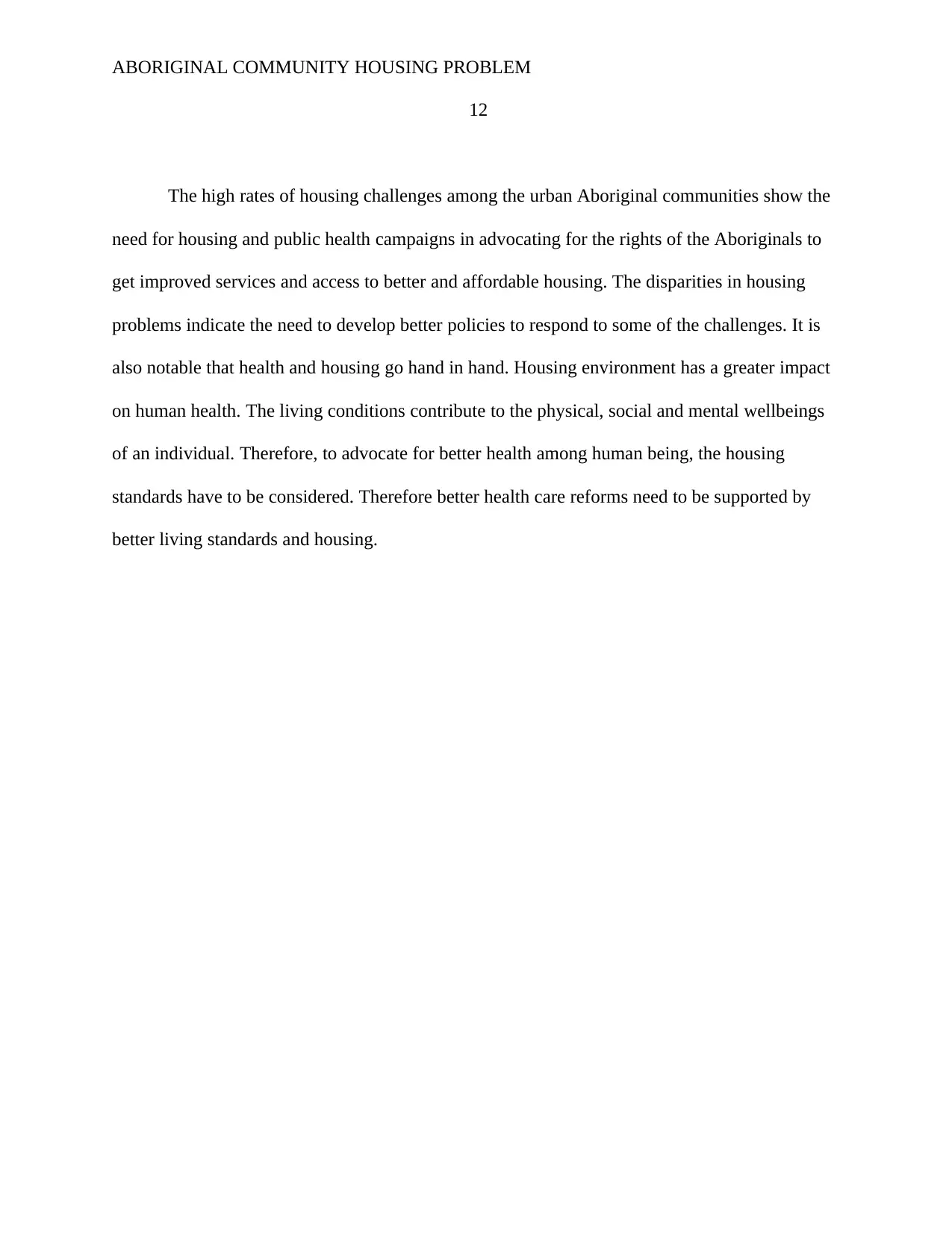
ABORIGINAL COMMUNITY HOUSING PROBLEM
12
The high rates of housing challenges among the urban Aboriginal communities show the
need for housing and public health campaigns in advocating for the rights of the Aboriginals to
get improved services and access to better and affordable housing. The disparities in housing
problems indicate the need to develop better policies to respond to some of the challenges. It is
also notable that health and housing go hand in hand. Housing environment has a greater impact
on human health. The living conditions contribute to the physical, social and mental wellbeings
of an individual. Therefore, to advocate for better health among human being, the housing
standards have to be considered. Therefore better health care reforms need to be supported by
better living standards and housing.
12
The high rates of housing challenges among the urban Aboriginal communities show the
need for housing and public health campaigns in advocating for the rights of the Aboriginals to
get improved services and access to better and affordable housing. The disparities in housing
problems indicate the need to develop better policies to respond to some of the challenges. It is
also notable that health and housing go hand in hand. Housing environment has a greater impact
on human health. The living conditions contribute to the physical, social and mental wellbeings
of an individual. Therefore, to advocate for better health among human being, the housing
standards have to be considered. Therefore better health care reforms need to be supported by
better living standards and housing.
⊘ This is a preview!⊘
Do you want full access?
Subscribe today to unlock all pages.

Trusted by 1+ million students worldwide
1 out of 16